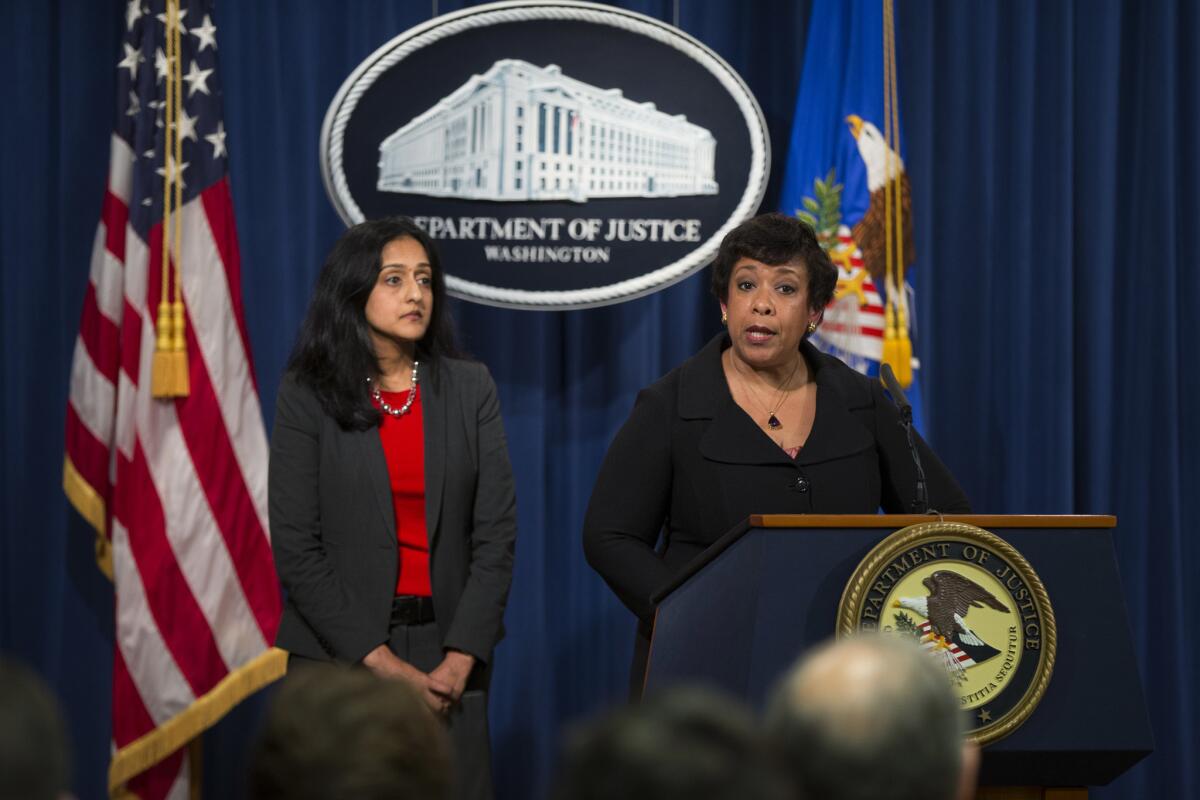Op-Ed: It‚Äôs illegal to discriminate ‚Äėbecause of sex.‚Äô But what does that actually mean?

The Department of Justice last week threw down the gauntlet in North Carolina, filing a lawsuit alleging that the state violated federal anti-discrimination laws by restricting trans individuals‚Äô access to bathrooms in state government buildings. One of those federal laws, Title VII of the 1964 Civil Rights Act, forbids employment discrimination because of race, color, national origin, religion ‚Äď and sex. DOJ says that North Carolina has engaged in sex discrimination, because, in DOJ‚Äôs view, ‚Äúsex‚ÄĚ includes ‚Äúgender identity.‚ÄĚ
The government‚Äôs interpretation of that word ‚ÄĒ ‚Äúsex‚ÄĚ ‚ÄĒ has broadened significantly since Title VII‚Äôs passage. Indeed, the Equal Employment Opportunity Commission, the federal agency created by Title VII and vested with primary enforcement authority for the statute, initially understood ‚Äúbecause of sex‚ÄĚ to mean no more than overt disadvantages to women in favor of men, and showed no interest in enforcing the provision at all. It‚Äôs taken decades for the legal understanding of sex to arrive at where it is today, and it‚Äôs a progression that maps, and mirrors, our cultural understanding of sex as more than just biology.
‚ÄĒ‚ÄĒ‚ÄĒ‚ÄĒ‚ÄĒ‚ÄĒ‚ÄĒ
‚ÄúSex‚ÄĚ was added to Title VII‚Äôs list of protected characteristics at the last minute by Rep. Howard Smith of Virginia, an avowed opponent of the Civil Rights Act. Although Smith was, incongruously, a longtime supporter of the Equal Rights Amendment, his jocular tone during much of the floor debate on the sex amendment suggested that he was less than serious about winning its adoption. (Historians have come to believe that Smith likely was sincere, if only because he feared that an employment rights bill that protected against race but not sex discrimination would place white women at a disadvantage in the workplace.) The amendment ultimately passed, but not without a good deal of bemused commentary from House members ‚ÄĒ only 12 of whom were women ‚ÄĒ at the notion that women should stand on equal footing in the workplace.
The unceremonious addition of ‚Äúsex‚ÄĚ to Title VII prompted a dismissive attitude among the EEOC‚Äôs leadership. When a reporter at a press conference asked Franklin D. Roosevelt, Jr., the agency‚Äôs first Chair, ‚ÄúWhat about sex?‚ÄĚ he had only a joke for an answer. ‚ÄúDon‚Äôt get me started,‚ÄĚ he said. ‚ÄúI‚Äôm all for it.‚ÄĚ Another of the agency‚Äôs first leaders wrote off the Title VII sex provision as a ‚Äúfluke‚ÄĚ that was ‚Äúborn out of wedlock.‚ÄĚ
Not surprisingly, then, although fully one-third of the charges filed with the EEOC in its first year of existence alleged sex discrimination, the agency was slow to articulate what illegal discrimination ‚Äúbecause of sex‚ÄĚ even meant. It waffled, for instance, on whether to sanction job ads that were separated into ‚Äúhelp wanted ‚ÄĒ male‚ÄĚ and ‚Äúhelp wanted ‚ÄĒ female,‚ÄĚ or the airline industry‚Äôs widespread rules that female flight attendants couldn‚Äôt be married, over the age of 30 or pregnant.
But thanks to pressure from feminist lawyers within the EEOC, as well as forces outside it ‚ÄĒ notably the National Organization for Women, founded in part to protest the agency‚Äôs cavalier Title VII enforcement ‚ÄĒ the agency began to right itself.
In 1968, it ruled that sex-segregated ads violated Title VII, and that flight attendants should not be subject to marriage and age restrictions. In 1972, it updated its ‚ÄúGuidelines on Discrimination Because of Sex‚ÄĚ to prohibit pregnancy discrimination and sex-differentiated terms in employer pension plans. In even later versions of the Guidelines, the EEOC disapproved ‚Äúfetal protection policies‚ÄĚ that disqualified women from jobs that involved exposure to dangerous chemicals, declared bias against workers with caregiving responsibilities to be a form of sex discrimination, and adopted a definition of pregnancy discrimination that imposed robust obligations on employers to accommodate pregnant employees‚Äô physical limitations.
The Supreme Court‚Äôs rulings about Title VII‚Äôs sex provision ... have given us a definition of ‚Äúsex‚ÄĚ that is expansive and ever-evolving.
The Supreme Court‚Äôs rulings about Title VII‚Äôs sex provision ‚ÄĒ which are controlling on the federal courts that hear such claims ‚Äď mirrored the EEOC‚Äôs progress, and have given us a definition of ‚Äúsex‚ÄĚ that is expansive and ever-evolving.
Since 1964, ‚Äúsex discrimination‚ÄĚ has come to mean far more than Title VII‚Äôs framers could have imagined. For one thing, men have long been able to claim Title VII‚Äôs protections, too. Moreover, sexual harassment, which did not even have a name until 1975, has been recognized as discrimination ‚Äúbecause of sex,‚ÄĚ and it is illegal whether it occurs between employees of the same sex or different sexes. Height and weight restrictions that disproportionately exclude women applicants ‚ÄĒ usually deployed in historically male jobs like law enforcement and firefighting ‚ÄĒ also can be discrimination ‚Äúbecause of sex.‚ÄĚ
The Court also has repeatedly affirmed that the law protects women whose very identities set them apart in some way from other women ‚ÄĒ mothers versus women without children, pregnant versus non-pregnant women, women whose dress and demeanor is more ‚Äúmasculine‚ÄĚ than the norm.
This last principle was enshrined in the Court‚Äôs 1989 Price Waterhouse v. Hopkins decision. The plaintiff, Ann Hopkins, was denied partnership at the Big Eight accounting firm because it was decided she needed to ‚Äúwalk more femininely, talk more femininely, dress more femininely, wear make-up, have [her] hair styled, and wear jewelry.‚ÄĚ The justices ruled that Price Waterhouse‚Äôs discrimination against Hopkins for being the wrong kind of woman was just as illegal as if it had precluded all women from becoming partners.
Recognition that sex encompasses not just one’s biology, but conformance with a wide variety of expectations about appearance, demeanor and identity underpins the movement to win Title VII coverage for lesbian, gay and bisexual workers as well as trans employees. But in this one area, trans individuals attracted legal attention before the LGB community.
Trans workers were the most obvious analogues to Ann Hopkins ‚ÄĒ in that their appearance deviates from gender stereotypes about what a ‚Äúreal man‚ÄĚ or ‚Äúreal woman‚ÄĚ should look like. The EEOC, in both its internal rulings and in its lawsuits on behalf of wronged individuals, therefore initially concentrated its efforts on those workers. Only after having achieved some success on trans rights did the agency move aggressively to win recognition of sexual orientation as ‚Äúsex‚ÄĚ under Title VII.
In one recent case, the EEOC alleged that Pittsburgh telemarketer Dale Baxley‚Äôs supervisor mused about Baxley‚Äôs relationship with his now-husband, ‚ÄúWho‚Äôs the butch and who is the bitch?‚ÄĚ Similarly, in its case on behalf of lesbian Baltimore forklift operator Yolanda Boone, the EEOC claims that Boone‚Äôs manager opined she ‚Äúwould look good in a dress,‚ÄĚ and asked, ‚ÄúAre you a girl or a man?‚ÄĚ
Put differently, Baxley is the wrong kind of man because he has a husband, and Boone‚Äôs very legitimacy as a woman is questioned because she is attracted only to other women. Such punishment for non-conformity with sex stereotypes is precisely what the Supreme Court confirmed in Price Waterhouse is discrimination ‚Äúbecause of sex.‚ÄĚ
During her remarks this week announcing DOJ‚Äôs lawsuit, Attorney General Loretta Lynch noted, ‚ÄúThis action is about a great deal more than just bathrooms.‚ÄĚ She‚Äôs right. Including gender identity within the legal meaning of ‚Äúsex‚ÄĚ isn‚Äôt revolutionary; it‚Äôs a natural step in a process that‚Äôs been unfolding for 52 years ‚ÄĒ and hasn‚Äôt stopped yet.
Gillian Thomas is a senior staff attorney at the ACLU Women‚Äôs Rights Project and author of ‚ÄúBecause of Sex: One Law, Ten Cases, and Fifty Years That Changed American Women‚Äôs Lives at Work.‚ÄĚ
Follow the Opinion section on Twitter @latimesopinion and Facebook
More to Read
A cure for the common opinion
Get thought-provoking perspectives with our weekly newsletter.
You may occasionally receive promotional content from the Los Angeles Times.










